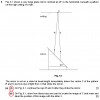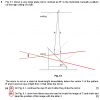- Messages
- 657
- Reaction score
- 1,447
- Points
- 143
Lenz's law: induced current flows in a direction such that it oposes its cause
No north on left stated ...
pole on coil always develops opposite pole of magnet what is brought close ... THAT is lenz's law ... magnet moves in: north on left to oppose(repel) .. magnet moves out : south on left to oppose(attract)
they've clearly drawn that dot saying centre of circle turned by car: that's the centripetal force
The car turns in the direction of the resultant force but the centripetal force is towards the center of the circle. There are two forces on the car one from the engine and one due to friction (Centripetal). The resultant is because of the different directions of the these forces. Right? So if we use a graphical method the resultant direction should be in the direction of C?In qs like these,the object is moving in a circle at a constant speed,so due to centripetal force the resultant will always be towards the center of the circle.


